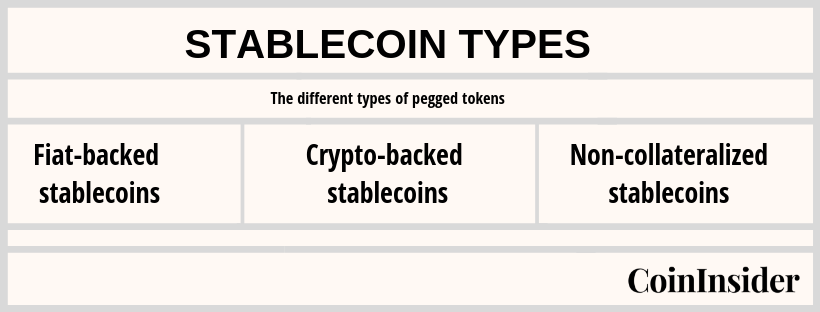Wie Man Gefälschte Kryptowährungen Erkennt Und Betrug Vermeidet
Wie Man Gefälschte Kryptowährungen Erkennt Und Betrug Vermeidet

Cryptocurrency stablecoins seem to be the key to bridging the gap between the benefits of cryptocurrencies and the slightly more stable nature offered by fiat currencies. The security of a non-volatile digital payment instrument backed by both a national currency and a blockchain sounds like a deal that can’t be ignored. So how do stablecoins work? What types of stablecoins are there? And what’s the catch?
What is a stablecoin?
Simply put, in the cryptocurrency space, a stablecoin is a token whose value is tied to the price of a national currency to combat its volatility. There are several types of stablecoins and numerous options and different projects that offer the same basic idea of a cryptocurrency coin that is more stable than Bitcoin or altcoins .
What types of stablecoins are there?
There are three types of stablecoins, namely

These are the cryptocurrencies that are pegged to a national currency, such as Tether, which is pegged 1:1 to the US dollar. This is the simplest way a stablecoin can be developed. As the name suggests, fiat currency must be deposited as collateral for a fiat-collateralized stablecoin to exist. From there, the tokens are issued at a 1:1 ratio against the collateralized fiat currency.
This is a simple method, but requires regular auditing and a treasury manager to ensure that the token remains fully collateralized – which has the disadvantage of centralizing the token by one party.
Just as a fiat-collateralized stablecoin has fiat tender as collateral, a crypto-collateralized stablecoin has cryptocurrency locked as collateral, such as Ethereum.
To offset the volatility of the collateralized cryptocurrency, the stablecoin will require a collateral security. This means that the coin will not have a 1:1 ratio to the cryptocurrency; it will look more like a $2 collateral for every $1 stablecoin issued.
There are stablecoins that use a seigniorage shares system. Seigniorage is the difference between the value of money and the cost of printing the money. Uncollateralized stablecoins rely on a mechanical algorithm that changes the supply volume as needed to maintain their price.
By using smart contracts, the stablecoin sells itself when the price falls below the pegged currency and delivers more tokens to the market when the value rises above the pegged currency.
With all this in mind, you may be wondering what the best stablecoins are.
Although we cannot answer this for legal and subjective reasons, we can offer you a list of the most popular stablecoins. There are numerous stablecoins in circulation, so we will limit ourselves here to the six most popular stablecoins in terms of popularity and trading volume.
Tether is arguably the most well-known stablecoin in the cryptocurrency market today. Pegged at a 1:1 ratio to the US dollar, Tether is one of the most successful stablecoins that has been adopted by cryptocurrency exchanges looking to use the token as an entry-level currency when direct USD transactions are not possible. This could be due to factors such as country-specific regulations.
One of the main advantages of Tether is that it maintains its value at $1 and investors and traders can use this to avoid exchange fees and transaction costs.
Although Tether has advantages, such as offering a token that has absolute stability with the US dollar, the stablecoin has also attracted negative attention from critics, citing the token’s centralization, transparency, and unfulfilled promise of official auditing.
While Tether might have the badge of honor as the first stablecoin, TrueUSD is a fiat-backed cryptocurrency that enjoys more trust among critics. The stablecoin has managed to earn a reputation for transparency through regular audits, is fully collateralized, and meets regulatory requirements for USD peg.
TrueUSD has partnerships with numerous banks and trusts to distract from the centralized status that Tether has. Thanks to smart contracts, TrueUSD has no way to access the funds – ensuring complete decentralization.
MakerDAO zielt darauf ab, die einheimischen Maker-Token und die Ethereum-Blockchain zu nutzen, um die Preisvolatilität zu minimieren. Um die Stablecoin zu besichern, nutzt MakerDAO Ethereum unter Verwendung eines intelligenten Kontrakts, und die Ether-Sicherheit sammelt sich zu einem so genannten Pooled Ether (PETH), der es dem intelligenten Kontrakt ermöglicht, im Laufe der Zeit die DAI-Token und Zinsen von MakerDAO zu generieren. Das gewonnene Interesse wird als „Stabilitätsgebühr“ bezeichnet, was bedeutet, dass die Nutzer den gleichen Betrag an DAI zurückzahlen müssen, wenn sie Ether aus dem Vertrag zurückziehen wollen.
Das letztendliche Ziel von Base ist es, den Token zu einem Index-Angebot zu machen, wobei die Basis bestrebt sein wird, seine Stabilität zu gewährleisten, indem sie seinen Wert an eine Vielzahl von Vermögenswerten koppelt. Darüber hinaus hofft das Projekt, zwei weitere Währungen als Hebel einsetzen zu können, um sein Angebot aufrechtzuerhalten. Die Token-Inhaber können ihre Token für Anleihen verkaufen, um im Laufe der Zeit Zinsen für ihre Investition zu erhalten, und Basecoin-Aktien werden ausgegeben, wenn das Angebot der Stablecoin erweitert werden muss.
Kryptogeld-Exchange Tokens werden entwickelt und existieren, um ihre unterstützenden Kryptogeldbörse zu dienen. Es gibt börsengetriebene Stablecoins wie den Gemini-Dollar, die den Gemini-Benutzern ermäßigte Gebühren beim Handel mit dem einheimischen Token der Börse bieten und gleichzeitig sicherstellen, dass der Gemini-Dollar im Verhältnis 1:1 an den USD gebunden ist.
Es wurden Argumente sowohl für als auch gegen Stablecoins vorgebracht.
Befürworter von Stablecoins haben argumentiert, dass diese Coins ein perfektes Modell darstellen, um die Schlüsselelemente dessen zu erfüllen, was eine Währung ausmacht. Das bedeutet, dass sie ein Tauschmittel, ein Wertaufbewahrungsmittel und eine Rechnungseinheit bieten. Darüber hinaus bieten Stablecoins die Vorteile der Blockchain und vermeiden gleichzeitig die inhärente Volatilität von Kryptowährungen.
In diesem Fall könnten Stablecoins der nächste Schritt zu einer breiten Einführung sein, was letztlich der Kryptogeldindustrie zugute kommt.
Auf der anderen Seite haben andere argumentiert, dass Währungen wie der US-Dollar aufgrund ihres eigenen inflationären Charakters keine gute Sicherheit darstellen. Aus diesem Grund sind die Stablecoins keine nachhaltige Lösung für genau dasselbe Problem, das Bitcoin zu lösen versucht. Darüber hinaus könnte man sagen, dass die Stablecoins sehr wohl den gesetzlichen Finanzgesetzen des Landes unterliegen, da das Verhältnis der Fiat-Pegges so eklatant von einer nationalen Ausschreibung abgeleitet ist.
Where a person can buy a stablecoin depends on which stablecoin they want to buy and what area they live in. The New York-based exchange Gemini would obviously be the best choice to buy Gemini coins. The first step would be to decide if you want a fiat, crypto, or non-collateralized stablecoin, and then choose which token best suits your trading needs.
Tether can be purchased on many cryptocurrency exchanges, such as Coindirect .
Wie Man Gefälschte Kryptowährungen Erkennt Und Betrug Vermeidet
10 Gründe, Warum Sie In Kryptowährungen Investieren Sollten
Was Ist Die Zukunft Der Kryptowährung? Die Wichtigsten Zu Beobachtenden Trends
Wer Akzeptiert Kryptowährungen Und Bitcoin